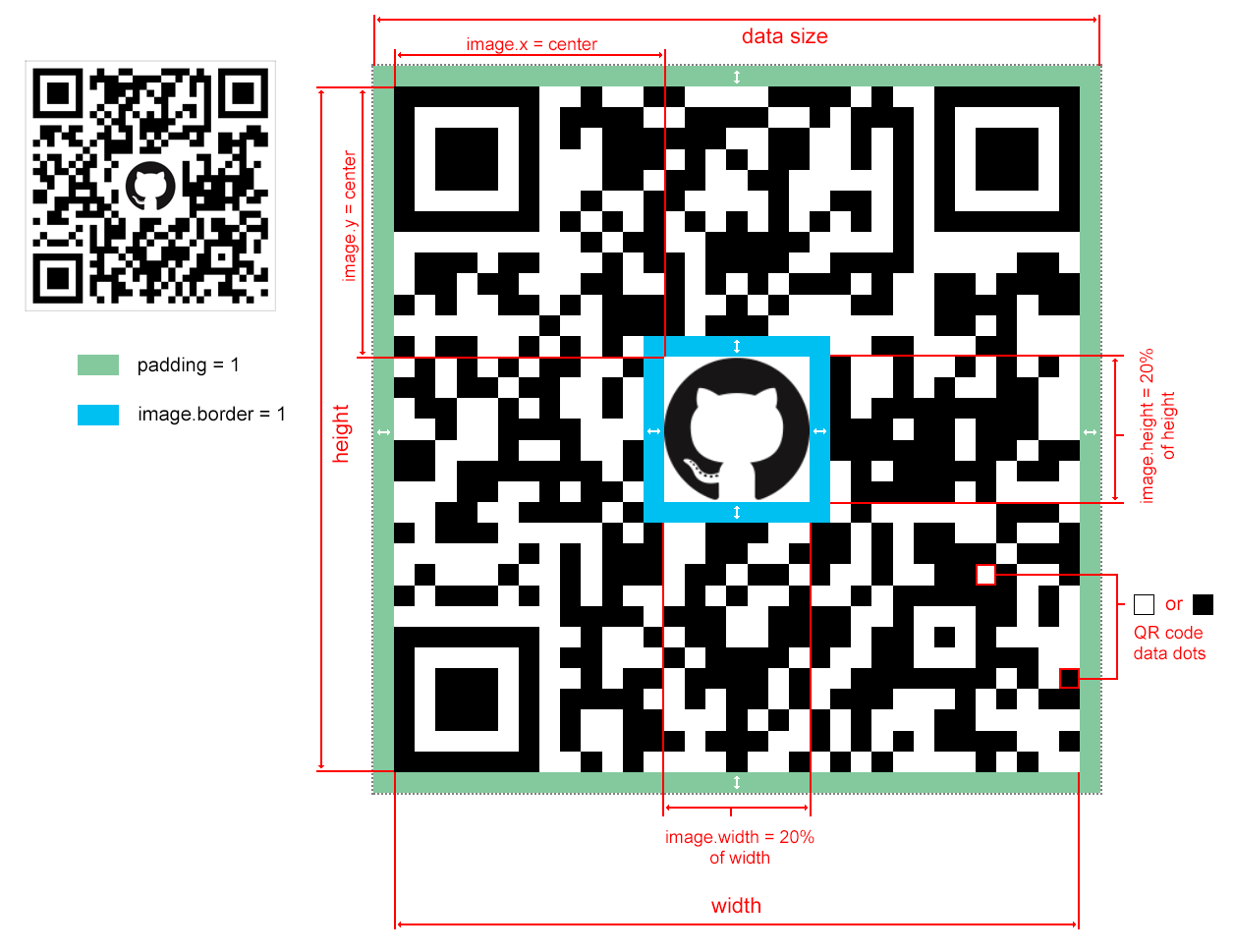README
@cheprasov/react-qrcode (v1.0.1)
The library is for generating QR codes. The library is React wrapper for library @cheprasov/qrcode
Features:
it is easy to use and configure (error correction level, type number, padding and so on).
Supports inverting of data.
Support image/logo on QR-code.
The library is covered by tests.
The library has typescript definitions.
QRCodeImg
- Render QR-code like dataUrl:
<img src="data:image/png;base64,..." alt="..." /> - Supports adding a image (logo) to QR code (allows to use url, dataUrl, Image, Canvas).
- It is possible to specify scale or blocks size.
- Allows to specify relative/abcolute position/size of image on QR code.
- Render QR-code like dataUrl:
1. How to install
> npm install @cheprasov/react-qrcode
import { QRCodeImg } from '@cheprasov/react-qrcode';
2. Quick examples
2.1. Create SVG QR Code
import { QRCodeImg } from '@cheprasov/react-qrcode';
//...
return (
<QRCodeImg value="https://github.com/cheprasov/ts-react-qrcode" />
);
//...
2.2. Create Image QR Code
import { QRCodeImg } from '@cheprasov/react-qrcode';
return (
<QRCodeImg
value="https://github.com/cheprasov/ts-react-qrcode"
image={{
source: 'GitHub-Mark-120px-plus.png',
width: '20%',
height: '20%',
x: 'center',
y: 'center',
}}
/>
);
Result:
Note, padding & image.border = 1 by default.

3. Documentation
3.1. class QRCodeImg
The class for creating img element with QR-code as dataUrl.
import { QRCodeImg } from '@cheprasov/react-qrcode';
Props:
value(string) - new value for encoding to QR code.alt(string, optional) - alt text for img element.level(string, optional, default =L) - error correction level. Note, the level affects QR Code data size. Allowed values:L- Allows recovery of up to 7% data lossM- Allows recovery of up to 15% data lossQ- Allows recovery of up to 25% data lossH- Allows recovery of up to 30% data loss
invert(boolean, optional, default =false) - inverting data of QR code.padding(number, optional, default =1) - count of white spaces on sides QR code. 1 unit has size like 1 information dot.fgColor(string, optional, default =#000) - foreground color of the QR code, is it allowed to use the next formats:RGBor#RGB, example:#ABC, will be converted to#AABBCCRGBAor#RGBA, example:#ABCD, will be converted to#AABBCCDDRRGGBBor#RRGGBB, example:#AABBCCRRGGBBAAor#RRGGBBAA, example:#AABBCCDD- Other formats (like
red,rgb(...),rgba(...)) are not supported and will be converted to#0000
bgColor(string, optional, default =#FFF) - background color of the QR code, see description offgColor.scale(number, optional, default =10) - scale size of QR code. For example, when scale is 5 then QR generator will use 5 pixel for draw 1 data dot.size(number, optional, default =null) - size (width & height) of canvas in pixels. If size is specified then scale param will be ignored. Note, that the original canvas with QR code will be stretched to the specified size. See image schemeimage(object, optional, default =null) - parameters on an image, that should be added to QR code, like logo.source(string|Image|Canvas) - source of image for QR Code, allowed to use the next types:string- url to resource or dataUrl of image.Image- it is allowed to use Image. The image's src should be loaded before use it.Canvas- allowed to use HTML5 canvas element.
width(number|string) - width of the image in QR code dots (not a pixel), allowed formats:<number>- defines the width of image, example:width: 30<number>%- defines the width in percent of QR code without padding, example:width: '20%'
height(number|string) - height of the image in QR code dots, seewidthx(number|string, optional, default =0) - position of image on QR code by horizontal in QR code dots (not a pixel), allowed formats:<number>- sets the left edge position from left to right, example:x: 10<number>%- sets the left edge position in % of QR code without padding. Negative values are allowed. Example:x: '50%'left- aligns the image to the left, example:x: 'left'right- aligns the image to the right, example:x: 'right'center- Centers the image in center of QR code, example:x: 'center'left <number>- the same as<number>left <number>%- the same as<number>%right <number>- sets the right edge position from right to left, example:x: 'right 5'right <number>%- sets the tight edge position in % of QR code without padding, example:x: 'right 10%'
y(number|string, optional, default =0) - position of image on QR code by vertical in QR code dots (not a pixel), allowed formats:<number>- sets the top edge position from top to bottom, example:y: 10<number>%- sets the top edge position in % of QR code without padding. Negative values are allowed. Example:y: '50%'top- aligns the image to the top, example:y: 'top'bottom- aligns the image to the bottom, example:y: 'bottom'center- Centers the image in center of QR code, example:y: 'center'top <number>- the same as<number>top <number>%- the same as<number>%bottom <number>- sets the bottom edge position from bottom to top, example:y: 'bottom 5'bottom <number>%- sets the bottom edge position in % of QR code without padding, example:y: 'bottom 10%'
border(number, optional, default = 1) - white space length around the images in dots. Negative values are allowed.- use
0- for white space only under the image - use
nullto remove any white spaces under image and leave QR data dots Example
- use
import { QRCodeImg } from '@cheprasov/react-qrcode';
// ...
return (
<QRCodeImg
value="foo"
bgColor="#f00"
fgColor="#AAA"
invert={true}
level="Q"
padding={2}
scale={42}
size={100}
image={{
source: 'some.png',
width: '10%',
height: '10%',
}}
/>
);
// ...
Something does not work
Feel free to fork project, fix bugs, write tests and finally request for pull
